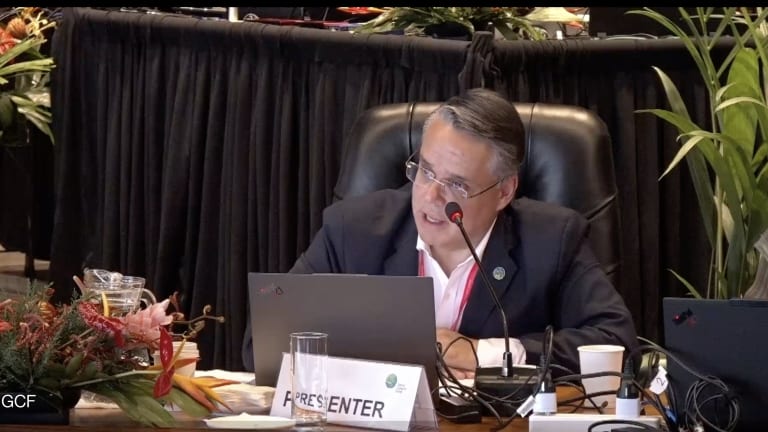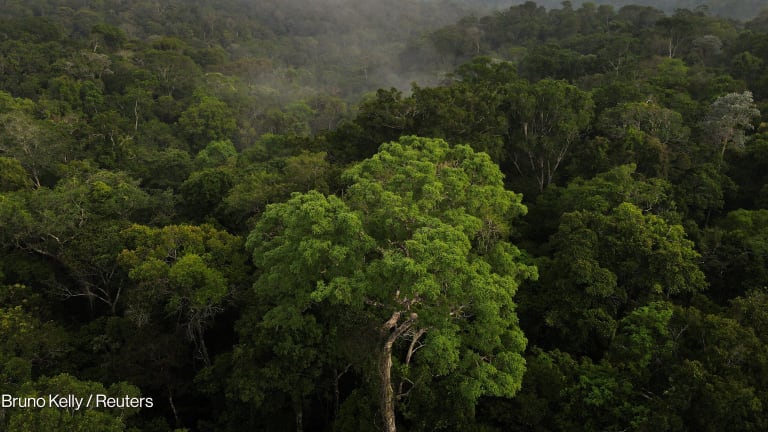The world's largest international climate funds
The world has set $100 billion a year to support global climate action but the degree to which donor countries are fulfilling financial commitments is a contentious and complex issue. Devex analyzed the largest multilateral and bilateral international climate funds that will help mobilize the money needed to confront climate change.
Developed countries committed to the U.N. Framework Convention on Climate Change have set a goal of jointly mobilizing $100 billion a year since 2009 to support climate action in the world’s poorest countries. The pledges were defined in the Copenhagen accord then formally adopted by the United Nations in the Cancun agreements a year later. And at the 2015 Paris climate talks, the world agreed to continue aspiring to the $100 billion target until 2025 by which point a new and ideally larger goal will be set. The degree to which donor countries are fulfilling financial climate commitments is a contentious and complex issue. According to a 2015 study conducted jointly by the Organization for Economic Cooperation and Development and the Jakarta-based Climate Policy Initiative, donors in 2014 were almost two-thirds of the way toward their $100 billion goal having mobilized roughly $62 billion in public and private aid. The report — the largest effort yet to quantify progress on climate finance — faced criticism from some environment and development groups. The South Africa-based NGO ActionAid called it “misleading” because the report included market-rate loans and export credits that benefit “actors in rich countries.” Meanwhile, the international development community is pushing for the mobilization of trillions not just billions of dollars. There is no internationally agreed definition of what constitutes climate finance, nor does the world have a precedent or blueprint for how to mobilize this massive amount of money. To help the international development community begin to grasp what money is out there and what are the gaps, Devex analyzed the largest multilateral and bilateral international climate funds. We found that funding for projects that help the world’s most climate-vulnerable countries adapt to the realities of a warmer world is increasing substantially, but remains noticeably under pledged levels. Further, adaptation projects have lagged behind support for mitigation projects, which tend to support middle-income countries where emissions are already high and growing rapidly. After protection of forests was permanently enshrined in the Paris agreement, REDD-plus programs, which aim to cut emissions by providing financial incentives to reduce deforestation and promote forest conservation, are attracting new funding. At the Paris climate talks, Germany, Norway and the United Kingdom cumulatively committed $5 billion for REDD-plus over the next five years in addition to the estimated $10 billion in international investment REDD-plus programs attracted in the lead up to the talks. Multilateral funds 1. Green Climate Fund Became operational: 2015 Executive director: Héla Cheikhrouhou, who reports to 24 independent board members. Cheikhrouhou’s term ends in September 2016 and the GCF is currently accepting applications for her replacement. Total amount pledged by donors: $10.3 billion Total amount signed/available for disbursement: $9.9 billion Main source of funding: Received commitments from 42 countries with the largest coming from the European Union, United States and Japan. The GCF is the newest and largest dedicated international climate fund. It aims to support risky, “paradigm shifting” projects and provide equal amounts of funding to mitigation and adaptation projects with at least 50 percent of support for the latter going to least developed countries, small island developing states and African states. It is one of the main institutions supporting the implementation of the 2015 Paris agreement. For 2016, GCF plans to approve project proposals totaling $2.5 billion, but halfway through the year, it has only achieved about 10 percent of its target. It has committed around $257 million to nine projects. To date, the GCF has approved 17 projects, but has yet to make any financial disbursements. 2. Climate Investment Funds Became operational: 2008 Administrator: Secretariat at the World Bank Total amount pledged by donors: $8.3 billion Total amount received from donors: $8.2 billion Main source of funding: Received pledges from 14 countries with the largest coming from the U.K., U.S. and Japan. Climate Investment Funds, better known as CIFs, are implemented through multilateral development banks and comprise of four programs: The Clean Technology Fund, which has disbursed $1.58 billion in support of large scale projects related to renewable energy, energy efficiency and transportation; the Pilot Program for Climate Resilience, which has disbursed $146.3 million helping developing countries strengthen their ability to adapt to climate change; the Scaling up Renewable Energy in Low Income Countries Program, which has disbursed $26.9 million to support the use of renewable energy to increase energy access and economic growth in the world’s poorest countries; and the Forest Investment Program, which has disbursed $36.1 million to assist developing countries in reducing emissions from deforestation and promotes sustainable forest management. The future of the CIFs will be decided in June 2019. 3. Global Environment Facility Became operational: 1991 Administrator: The GEF Secretariat, headed by CEO and Chairperson Naoko Ishii Total amount pledged by donors exclusively for climate change projects: $5.08 billion Total amount received from donors exclusively for climate change projects: $5.06 billion Main source of funding: Overall, the GEF has received pledges from 40 countries with the largest coming from the US, Japan and Germany Climate change is only one of six focal areas supported by the GEF Trust Fund, but it has approved over 1,000 climate change related projects and remains the longest running dedicated public climate change fund. The GEF supports the implementation of multilateral environmental agreements and acts as a financial mechanism of the UNFCCC. It also administers several funds established under the UNFCCC including the Least Developed Countries Trust Fund, which has received almost $1 billion from donors, and the Special Climate Change Trust Fund, which has received $347.5 million from donors. Both funds focus on adaptation. The GEF is in the middle of its sixth funding cycle, but approved funding for cycle 5 is still being disbursed. The GEF is expected to last indefinitely. 4. Forest Carbon Partnership Facility Became operational: 2008 Administrator: The World Bank and implementing agencies Total amount pledged by donors: $1.057 billion Total amount received from donors: $693 million Main source of funding: Received pledges from 17 donors from the public and private sector with the largest coming from Norway, Germany and the U.K. FCPF is a global partnership of 47 developing countries focused on reducing emissions from deforestation and forest degradation as well as promoting the sustainable management of forests (REDD-plus). It is comprised of two funding mechanisms. The Readiness Fund, which will be in operation until 2020, has disbursed $82.5 million in projects that has helped 38 developing countries implement the necessary policies and systems to prepare for REDD-plus. Meanwhile, the Carbon Fund assists select countries that have made significant progress in their REDD-plus projects by implementing performance-based payments to ensure that the aforementioned countries provide long-term support for forest conservation and management programs. The Carbon Fund has yet to provide any results-based payments, but it has time. The Carbon Fund’s term has been extended until 2025. 5. Adaptation Fund Became operational: 2009 Administrator: Donors and recipients as equal partners Total amount the fund has received: $545 million Main source of funding: The original primary source of revenue for the Adaptation Fund — the sale of Certified Emission Reduction credits through a 2 percent levy on U.N. Clean Development Mechanism projects that help meet the Kyoto Protocol’s emission reduction targets — has drastically diminished since November 2011 due to market changes. Now, the fund is increasingly attracting funds through developed country and private donations. The fund has also received voluntary contributions from 17 donor governments with the largest coming from Germany, Sweden and Spain. The Adaptation Fund was established under the UNFCCC and its Kyoto Protocol to support concrete adaptation projects in developing countries that are party to the KP. The AF has committed almost $355 million to 55 projects, all of which are relatively small-scale compared to those approved by other international climate funds and has a $10 million funding cap per country. A maximum of 50 percent of total AF project funds can be channeled through accredited multilateral implementing entities to encourage more national implementing entities to apply for support. The fund pioneered the direct access approach, which is used by the Green Climate Fund, and is particularly important to developing countries because it enables national implementing entities to access funds directly without going through an international body. The Adaptation Fund will exist indefinitely. 6. Global Climate Change Alliance Established: Fully operational since 2008 Administrator: The European Commission’s Directorate-General for International Cooperation and Development Total amount donors pledged: At least 2 billion euros ($2.26 billion) annually since 2010 and 5-10 billion euros annually by 2020 Total amount received from donors: 343 million euros Main source of funding: European Commission The GCCA aims to build a new climate change alliance between the European Union and climate-vulnerable countries in the developing world. The GCCA has two main objectives. First to act as a platform for dialogue between the EU and developing countries on climate policy and second to offer technical and financial support to climate-vulnerable countries. Technical support focuses on adaptation and mitigation strategies, increasing resilience to climate stresses and poverty reduction. The GCCA was supposed to end in 2010, but it is still operational. In 2014, the GCCA grew into the GCCA-plus, which has many of the same objectives, but places greater emphasis on the binding role of communication and knowledge management. Funding is secured at least until 2020. Multidonor funds 1. Amazon Fund Became operational: 2009 Administrator: Brazilian Development Bank Total amount donors pledged: $1.748 billion Total amount received from donors: $1.037 billion Main source of funding: Norway, Germany and the Brazilian energy company, Petrobras The Amazon Fund aims to raise donations for non-reimbursable investments in initiatives that prevent, monitor and combat deforestation as well as support the sustainable use of forests in the Amazon. It has committed $573 million to 82 projects and has disbursed $231 million. Up to 20 percent of the fund’s resources can be used to assist in monitoring and controlling deforestation in Brazil’s and other tropical countries’ biomes. The fund is expected to run until the country achieves and maintains zero deforestation. Bilateral funds 1. U.K.’s International Climate Fund Became operational: 2011 Administrator: International Climate Fund secretariat, comprised of representatives from various U.K. departments. Total amount pledged to the ICF: 9.67 billion pounds ($12.7 billion) by 2021 Total amount the ICF has received: 3.87 billion pounds The U.K. government created the ICF to help developing countries transition to a lower-carbon future, build resilience to extreme weather events and promote better management of natural resources. ICF funding is split into three government departments: 1.33 billion pounds has been allocated to the Department of Energy and Climate Change, which is now part of the Department for Business, Energy and Industrial Strategy, 2.4 billion pounds to the Department for International Development and 140 million pounds to the Department for Environment, Food and Rural Affairs, which deals with forestry issues. The U.K. government aims to spend funding equally between adaptation and mitigation initiatives. The ICF is expected to run indefinitely. 2. Germany’s International Climate Initiative Became operational: 2008 Administrator: The German Federal Ministry for the Environment, Nature Conservation and Nuclear Safety Total amount the pledged to the initiative: 1.96 billion euros Total amount the initiative has received: 1.96 billion euros IKI funds climate initiatives in developing countries, newly industrialized countries, and countries in transition economies in the field of mitigation, adaptation, REDD-plus and biodiversity. GIZ and KfW, both organizations contracted by the German government to carry out development work, are some of the key implementers of the approved projects, but all funding decisions are made by the BMUB. IKI is expected to exist indefinitely. 3. Norway’s International Climate and Forest Initiative Became operational: 2008 Administrator: NICFI’s Secretariat within the Norwegian Ministry of the Environment Total amount pledged to the initiative: 19.7 billion Norwegian krone ($2.4 billion) as of 2016 plus 3 billion Norwegian krone per year until 2020. Total amount the initiative has received: 19.7 billion Norwegian krone The NICFI supports efforts to reduce greenhouse gas emissions from deforestation and forestation degradation in developing countries. Roughly 40 percent of the money the NICFI has spent has gone to the Amazon Fund. But, most of the NICFI’s funding is channeled through multilateral organizations, including the Forest Carbon Partnership Facility and the U.N. REDD Program. The NICFI will exist until 2030. Check out more insights and analysis for global development leaders like you, and sign up as an Executive Member to receive the information you need for your organization to thrive.
Developed countries committed to the U.N. Framework Convention on Climate Change have set a goal of jointly mobilizing $100 billion a year since 2009 to support climate action in the world’s poorest countries.
The pledges were defined in the Copenhagen accord then formally adopted by the United Nations in the Cancun agreements a year later. And at the 2015 Paris climate talks, the world agreed to continue aspiring to the $100 billion target until 2025 by which point a new and ideally larger goal will be set.
The degree to which donor countries are fulfilling financial climate commitments is a contentious and complex issue. According to a 2015 study conducted jointly by the Organization for Economic Cooperation and Development and the Jakarta-based Climate Policy Initiative, donors in 2014 were almost two-thirds of the way toward their $100 billion goal having mobilized roughly $62 billion in public and private aid.
This story is forDevex Promembers
Unlock this story now with a 15-day free trial of Devex Pro.
With a Devex Pro subscription you'll get access to deeper analysis and exclusive insights from our reporters and analysts.
Start my free trialRequest a group subscription Printing articles to share with others is a breach of our terms and conditions and copyright policy. Please use the sharing options on the left side of the article. Devex Pro members may share up to 10 articles per month using the Pro share tool ( ).
Fatima Arkin is a Devex contributor specializing in climate change, human rights, and sustainable development. She has reported across Asia, Africa, Europe, and North America for Foreign Policy, SciDev.net, Maclean's, and many others. She holds a B.A. in international development and history from McGill University and a graduate diploma in journalism from Concordia University, both located in Montreal, Canada.








